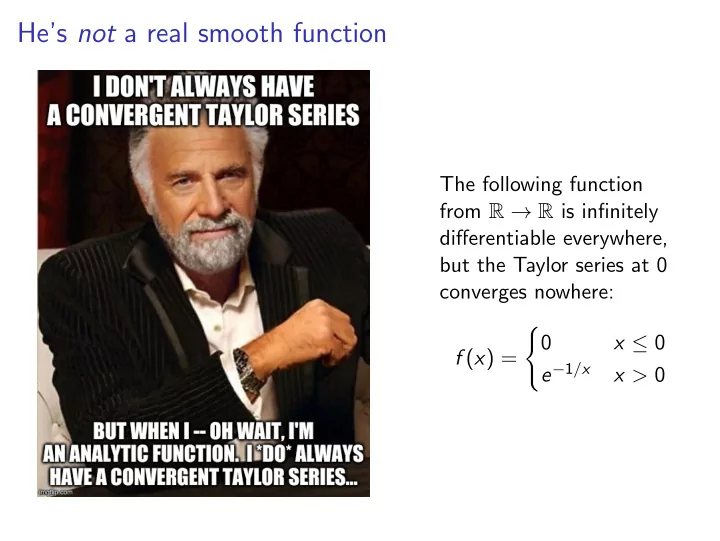

He’s not a real smooth function The following function from R → R is infinitely differentiable everywhere, but the Taylor series at 0 converges nowhere: � 0 x ≤ 0 f ( x ) = e − 1 / x x > 0
Analytic Functions have Taylor Series Theorem Let f be analytic on ∆ = { z : | z − z 0 | < r } , where r > 0 . Then f has a Taylor expansion about z 0 that is valid on all of ∆ : ∞ f ( n ) ( z 0 ) � ( z − z 0 ) n f ( z ) = n ! n =0 Proof. CIF + Expand 1 / ( w − z ) as geometric series in ( z − z 0 ) / ( w − z 0 ) Warning: Usual role of w and z in CIF reversed for this proof. Cool corollary The radius of convergence around z 0 is the distance to the first point w where f isn’t analytic. In particular, if f is entire (analytic on all of C ), then its Taylor expansions converge everywhere!
Calculating Taylor series When possible, avoid taking derivatives Too much work. Instead... ◮ Build from Taylor series you know: 1 / (1 − z ) , exp , sin , . . . ◮ Helps psychologically to substitute w = z − z 0 ◮ Can differentiate / integrate Taylor series term by term Examples: find Taylor series of... 1. 1 / ( z + 1) around z = 2 2. z 3 cosh( z 2 ) around z = 0 3. 1 / (1 − z ) 2 around z = 0
Zeroes of functions Definition Let f be analytic on a region D . We say w ∈ D is a zero of f if f ( w ) = 0. We say w is a zero of order k if f ( w ) = f ′ ( w ) = · · · = f ( k − 1) ( w ) = 0, but f ( k ) ( w ) � = 0. Example z sin( z ) has a zero of order 2 at 0, and a zero of order 1 at k π for 0 � = k ∈ Z Lemma f ( z ) has a zero of order k at a if and only if f ( z ) = ( z − a ) k g ( z ) , where g ( z ) is analytic on nonzero on an open set containing a. Corollary If f ( z ) has a zero of order m at a, and g ( z ) has a zero of order n at a, then f · g has a zero of order m + n at k.
Recommend
More recommend